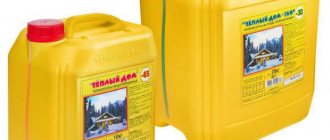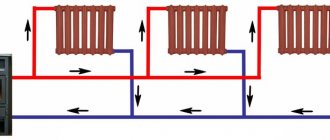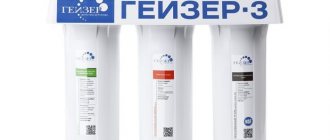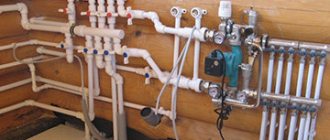In what cases antifreeze can not be used
Why is the question posed in this way? Everything is very simple - you can easily familiarize yourself with the specific positive qualities of antifreeze of any brand. Such information is actively disseminated by manufacturers. For our part, we want to present those features of this technical fluid, which they are trying to keep silent about:
- Antifreeze cannot be used in double-circuit boilers - it is possible to mix the coolant from the heating circuit into the water supply circuit. As you know, non-freezing liquid is poisonous by its physicochemical properties.
- In open systems, it also cannot be used - evaporation of the coolant is possible.
- The use of antifreeze in a system with a galvanized pipeline is unacceptable - it is fraught with chemical changes and the loss of its original properties.
- The heat capacity of the non-freezing liquid is lower than that of water, which means that more powerful radiator batteries will be required.
- The viscosity of antifreeze is also higher - more powerful circulation pumps are needed.
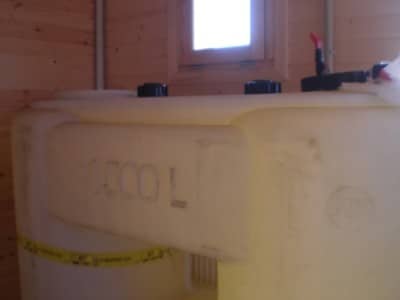
The tank for antifreeze must be large enough, and correctly calculated according to the project
Propylene glycol antifreeze
Propylene glycol in the heating system is not as toxic as the previous type. The composition of such antifreeze may contain food additives that are not dangerous even to human health.
True, the composition of such a coolant may contain various additives that can affect the materials from which various elements of the heating system are made. The way in which additives work depends on the material from which the components of the heating system are made. Some additives are needed so that various oxidations or foaming do not appear inside the heating system.
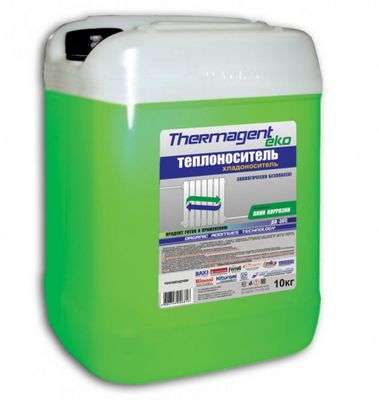

Propylene glycol antifreeze
Features when starting the heating system
The different composition of the solutions affects the operation of the heating system. This is how the presence of ethylene glycol influences the initial start-up phase of the system. The heating process must be started at low power, then gradually brought to the required level. This method will reduce the toxic effects of this substance.
The propylene glycol-based product does not need such adjustment of the heating equipment start-up.
When all the requirements are met, then there is no need to be afraid of using "anti-freeze" as a coolant. It will solve a lot of problems with skillful use.
The prices for antifreeze liquid are different, and the quality, accordingly, is also different. The policy here should be as follows: when there is no way to buy a good product, it is better to stay on the water. In this case, it is imperative to make sure that the coolant is drained from the system before the onset of frost, or turn on the heating devices on time.
Other components
The recipes for factory anti-freeze liquids necessarily contain surfactants. They are designed to remove dirt, grime, grime, oil and anything else that can obstruct your view from the glass surface.
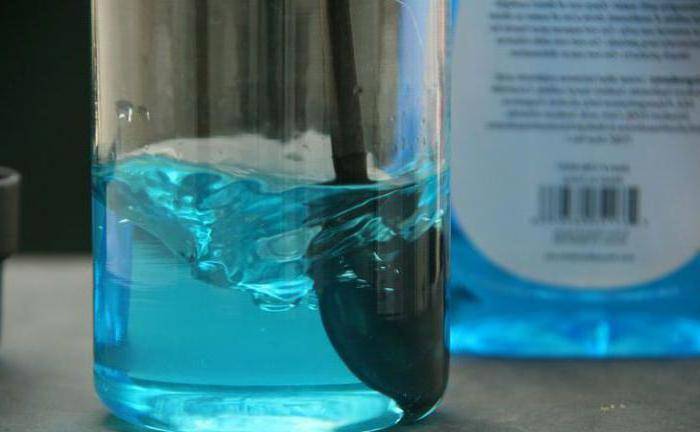

For the liquid to be effective in cleaning glass, very few surfactants are required. Flavors are also used in the manufacturing process. They serve to impart a pleasant aroma to the product. Manufacturers often use the smell of apples, citrus fruits or any other product with a persistent and “tasty” aroma. Dyes color the liquid in different colors. This makes it easier for the buyer to identify the desired product. Separately, it is necessary to say about water.For the manufacture of products of the highest class, distilled is best suited. In some cases, it is allowed to use artesian water with a minimum of salts. But the most ordinary (from the tap) is not suitable for making anti-freeze.
If you take an anti-freeze, what brand
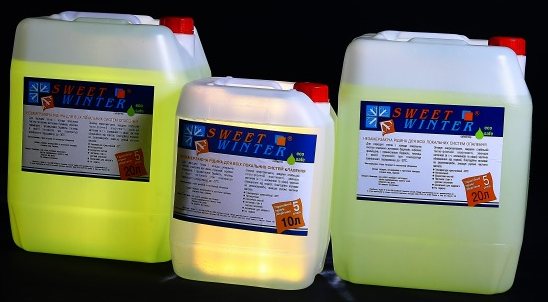

Heating fluids
The market today offers a variety of offerings for this specific product.
However, there are also leaders here. Heating fluid called "Warm House" is in great demand among consumers. This product is produced in Russia.
"Warm House" has been successfully used for many years, so we can say with confidence that the liquid has passed the test of time. And best of all, this antifreeze is characterized by reviews of homeowners who have considerable experience in operating heating systems using antifreeze liquid.
According to them, this brand does not lose its characteristics over ten heating seasons.
This fully corresponds to the service life declared by the manufacturer. As you know, reviews from satisfied consumers are the best proof of quality.
Also on hearing are such brands as "Energos Universal", "Energos Lux", "Thermagent", "Dixis", etc.
On the basis of ethylene glycol, Russian manufacturers produce antifreezes in two versions: with a freezing temperature of up to -30 ° C, and also with a freezing temperature of up to -65 ° C.
The aforementioned manufacturers are actively expanding the range of non-freezing heat carriers made on the basis of food-grade propylene glycol, ecologically safe raw materials. And this is not in vain, because the demand for heating antifreeze is growing, which means there should be a supply.
Cases in which it is strictly forbidden to use antifreeze
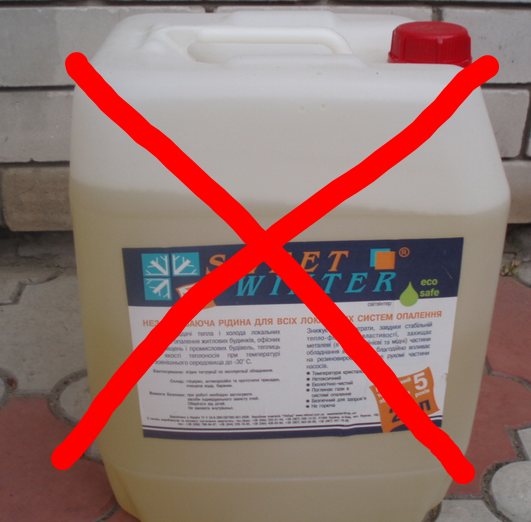

When you can't use antifreeze
It is not difficult to get acquainted with all the advantages of antifreeze from any manufacturer.
This information is actively advertised by trademarks. On the other hand, we should talk about the features of this liquid, which manufacturers try not to emphasize:
- It is forbidden to use antifreeze in double-circuit boilers. After all, the design features of this heating system are such that the coolant can leak from the heating kennel into the water supply circuit. And by its chemical properties, the non-freezing liquid is poisonous.
- It is strictly forbidden to use antifreeze in open systems, in which case it may evaporate.
- Also, do not use antifreeze in heating systems with galvanized pipelines. When interacting with them, loss of original properties and chemical changes are possible. It is not recommended to pour antifreeze into cast iron boilers. At the very least, you need to make sure that paronite gaskets are present in your unit, which can prevent the harmful effects of antifreeze. The technical data sheet of the product will help you with this.
- The heat capacity of antifreeze is lower than water, as a result, radiator batteries of greater power are needed.
- Since the viscosity of the non-freezing liquid is higher, more powerful circulation pumps will be required.
In any case, the final decision is always yours. It is impossible to say unequivocally which is better, water or non-freezing liquid.
It all depends on the individual heating parameters. Before making a final decision on the choice of a particular coolant, you should seek the advice of specialists.
DIY non-freezing liquid
In most countries, "non-freezing" is simply bought in specialized car stores. In Russia, there is such an option as to make an anti-freeze liquid yourself.
To do this, look at the tables above and simply mix water and base in the required proportions.To improve cleaning properties, it is also recommended to add a little common dish or glass detergent. One cap is enough for 5 liters of ready-made liquid.
A cheap antifreeze liquid can be made not only on the basis of alcohols, but also on the basis of other liquids: vinegar, ammonia, etc., although the quality and safety of such solutions cannot be completely sure.
In stores, you can find con and dilute it yourself with water to the required freezing temperature.
After making the liquid, you need to check it without pouring it into the washer tank - just leave it outside overnight if the temperature is negative or in the freezer of the refrigerator.
Antifreeze classification
There are many types of this product on the market. Non-freezing liquid for heating boilers can be made on the basis of an aqueous solution of glycerin, ethylene glycol, propylene glycol, and so on. Since all substances are highly corrosive, special additives are present in the composition of fluids.
Each species has certain specific characteristics:
- ethylene glycol-based liquid - common among buyers, since it has the most affordable cost. But it is the most toxic and cannot be used for double-circuit boilers. May be hazardous to health if released into the water supply system. If the boiling point rises above 110 degrees, the substance can form a precipitate that can interrupt the operation of a number of elements of the system;
- from propylene glycol - the properties of the composition are almost similar to the previous one, but it is less harmful and safer;
- based on glycerin - an environmentally friendly antifreeze, non-toxic, protects the system from corrosion. When going into a solid state, it does not increase the volume, but in order for the system to start, you just need to warm it up;
- from a natural solution of bischofite - has a high level of heat transfer and heat capacity, the freezing point is low, and the boiling point is high;
- salt carriers - made on the basis of solutions of sodium, calcium and other mineral salts. They are highly corrosive to pipes.
Specifications for glass washer and low freezing fluids
These specifications apply to windscreen and low-freezing fluids (hereinafter referred to as "liquid, products ") production LLC "XXX".
Windshield washer and low-freezing fluids are intended for use in a car windshield washer system in the spring-summer and autumn-winter periods to remove snow, ice, oil film, insects, salt and road deposits and other contaminants and are an aqueous solution of isopropyl and ethylene glycol alcohol containing surfactants, perfume and dye.
The liquid effectively dissolves dirt, does not leave streaks, deposits and iridescent films on glass, is neutral to body paint and to rubber and plastic parts of the car.
The liquid is produced on the basis of S1111 absolute isopropyl alcohol (3 ... 75%), softened water, ethylene glycol (4 ... 10%), surfactant 2% (neonol substance), dye (less than 1%), fragrances
(less than 1%).
An example of recording products in an order and / or in other documents:
"Windscreen washer fluid" Winter "TU 2384-001-XXXXX-2015".
"Low freezing liquid AZhN-1 TU 2384-001-XXXXX-2015".
These technical specifications are the property of LLC "XXX" and may not be partially or completely copied, duplicated or used without the permission of the owner.
The list of normative documents referenced in these technical conditions is given in Appendix A.
1 TECHNICAL REQUIREMENTS
1.1 Main parameters and characteristics
1.1.1 The liquid must be manufactured in accordance with the requirements of these technical specifications, the Unified Sanitary and Epidemiological and Hygienic Requirements for Goods Subject to Sanitary and Epidemiological Supervision (Control), Chapter 2, Section 19.
The liquid must be manufactured in accordance with the recipe and according to the technological regulations, agreed and approved in the prescribed manner.
1.1.2 The raw materials used for the manufacture of the liquid must comply with the requirements of the relevant regulatory documents.
1.1.3 Depending on the volume fraction of isopropyl alcohol, glass washer fluids are divided into grades "Summer" and "Winter".
—"Summer"- intended for use at temperatures over 0 ° C;
-"Winter"- intended for use at temperatures up to minus 20 ° C; up to minus 25 ° C; up to minus 80 ° C.
1.1.4 In terms of organoleptic and physicochemical characteristics, glass washer fluids must comply with the requirements and standards specified in table 1.
Table 1
| Indicator name | Characteristics and norm for brands | |||
| "Winter" | "Summer" | |||
| minus 20 ° С | minus 25 ° С | minus 80 ° С | more than 0 ° С | |
| 1 | 2 | 3 | 4 | 5 |
| Appearance, color, smell | Homogeneous transparent liquid of green or blue, or yellow colors with a scent odor. Slight turbidity and the appearance of a sediment are allowed, which does not affect the quality of the liquid | |||
End of table 1
| 1 | 2 | 3 | 4 | 5 |
| Density at 20 ° С, g / cm3 | 0,945… 0,955 | 0,92…0,94 | 0,85…0,89 | 0,96…1,000 |
| Mass fraction of isopropyl alcohol,%, not less | 32,0 | 51,0 | 80,0 | 3,0 |
| Hydrogen ion concentration index, pH | 7,5…9,0 | 8,0…9,5 | 9,0…11,0 | 7,5…9,0 |
| Crystallization start temperature, ºС, not higher | minus 20 ° С | minus 25 ° С | minus 80 ° С | — |
1.1.5 Depending on the volume fraction of ethylene glycol alcohol, low-freezing liquids are divided into grades:
- "АЖН-1" - intended for use at temperatures up to minus 20 ° C;
- "АЖН-2" - intended for use at temperatures up to minus 30 ° C;
- "АЖН-3" - designed for use at temperatures up to minus 40 ° C.
1.1.6 In terms of organoleptic and physicochemical characteristics, low-freezing liquids must comply with the requirements and standards specified in table 2.
table 2
| Name indicator | Liquid rate | |||
| АЖН-1 | АЖН-2 | АЖН-3 | ||
| 1 | 2 | 3 | 4 | |
| 1. Appearance | Transparent homogeneous colored liquid without mechanical impurities | |||
| 2. Density, g / cm | 1,11 | 1,106 | 1,102 | |
End of table 2
| 1 | 2 | 3 | 4 |
| 3. Temperature of the beginning of crystallization, ° С, not higher | minus 20 | minus 30 | minus 40 |
| 4. Content of ethylene glycol,% | 96 | 89 | 85 |
Notes: The color of the low-cooling liquid is set in the NTD for its specific type.
1.2 Marking
1.2.1... Transport marking of cargo must comply with the requirements of GOST 14192 and GOST 19433 (class 6, subclass 6.1, classification code 6161).
1.2.2... Requirements for the labeling of consumer containers are established in the NTD for a specific type of liquid.
1.3 Packaging
1.3.1 As a consumer container for liquids, a polymer container with a volume of 0.9, 4, 5, 10 liters according to NTD for a specific type of liquid is used.
1.3.2 Liquids packaged in consumer containers, during transportation, are packed in wooden boxes in accordance with GOST 18573.
1.3.3 Each box is packed with liquids of the same type and in the same consumer packaging.
The numbers and types of boxes are selected depending on the size, weight and number of consumer packaging units placed in each box, and indicate in the NTD a specific type of liquid.
1.3.4... By agreement with the consumer, liquids can be packed into other types of containers, which indicate in the NTD a specific type of liquid.
1.4 Completeness
1.4.1 The liquid is supplied to the consumer as a ready-to-use product.
1.4.2 The package should include:
- a batch of products (the scope of delivery is established by agreement with the customer);
- operational documents (passport, operation manual, packing list), corresponding to GOST 2.601.
8.1 The manufacturer guarantees the compliance of liquids with the requirements established in the NTD for this liquid, taking into account the requirements of these TU and subject to the conditions of their transportation and storage.
8.2... The guaranteed shelf life is at least 5 years.
How to do an anti-freeze: the main points
Whatever composition you prepare, it should:
- clean the windshield from dirt and ice;
- remain liquid at low temperatures;
- be safe for both humans and machine parts.
All, perhaps, nothing more is required from the washer.
As a rule, the base of antifreeze liquid includes ordinary distilled water, alcohol and some additives for flavoring, coloring and improving cleaning properties. Methyl, ethyl and isopropyl alcohols are used in production.
Methyl alcohol is harmful to health, therefore, non-freezing based on it is prohibited in Russia. And even if you have a canister of this substance lying around in your garage, you should not pour it into the car.
Isopropyl alcohol is extremely rare among the people; this technical liquid has a pungent smell. It can be asked from the one who repairs and cleans office equipment at home. True, such a master usually does not have more than half a liter in stock. And by the way it costs much more expensive than the same ethanol.
Ethyl alcohol is the most affordable option. Many have a bottle of medical, technical, or even food grade ethanol at home. However, no one canceled our favorite vodka either, because in essence it is an aqueous solution of ethyl alcohol.
To make anti-freeze in the washer at home, many also use salt, acids, detergents. But first things first.
Types of winter windscreen washers. Which anti-freeze is better?
Dozens of models of windscreen washers are presented in the modern car market, and you need to be able to choose a high-quality and effective liquid that will not freeze itself in severe frost, quickly clean the windshield of dirt and be safe for the driver and passengers. How to do it?
It is important to understand that all non-freezing are liquid mixtures of alcohol and water, and the main technical characteristics of the washer (freezing point and toxicity) depend on the amount of alcohol in the water. The quality of alcohol is also fundamentally important: all anti-freeze products are made on the basis of three alcohols:
- Methyl (methanol) is a highly toxic, odorless liquid that is dangerous to human health and is prohibited by law, but is often offered by counterfeit manufacturers and handicraftsmen. Methanol leads to loss of vision and general poisoning of the body, corrodes the rubber components of the windshield washer and removes dirt very poorly (it forms a film on cold glass and simply smears the dirt).
- Ethyl (ethanol) is the safest and most effective type of "non-freezing" with a slight smell of ordinary vodka. This is the best choice, but the price is high.
- Isopropyl is a safe and inexpensive windshield washer with a slight acetone odor. It is slightly less effective than non-freezing on ethanol, but it is sufficient at medium cold temperatures and safer than methanol mixtures.
Take this information into account when choosing windshield washers for driving in winter and look on the anti-freeze package label to clarify what alcohol is in the liquid (when buying, be sure to smell the composition).
In addition to this characteristic, the package must contain data on the kinematic viscosity (fluidity of a liquid at different temperatures), freezing point (crystallization), surface tension coefficient (ability to wet surfaces and penetrate into the structure of dirt), as well as the content of surfactant volatile substances (surfactants) ...
We offer you a small overview of the most popular winter windscreen washers on the domestic market, taking into account the above characteristics and efficiency at different temperatures.
Hi-Gear Premium Anti-freeze
This windshield washer is a high-quality isopropyl-based anti-freeze solution, which is produced in Russia under the license of a well-known American brand of automotive chemicals. Its advantages include:
- high efficiency of cleaning glasses from dirt and oil;
- activity at temperatures up to -25C;
- high cost savings;
- no spots and glare on the glass after use;
- no impact on human health;
- non-destructive effect on rubber and plastic elements of the windshield washer system.
Among the disadvantages: a fairly high cost and the presence on the market of a large number of "homemade" fakes (they have a too strong smell compared to the original).


German glass washer Liqui Moly (Russian production)
This anti-freeze is also a high-quality licensed product: it is produced in Russia under the control of the well-known German manufacturer of auto chemicals Liqui Moly based on isopropyl alcohol. Her advantages:
- guaranteed efficiency at -25C (however, it also works at -30C);
- well sprayed, does not clog windscreen washer nozzles (minimum kinematic viscosity);
- contains a minimum of surfactants (exclusive formula of the mixture), qualitatively washes dirt of any complexity;
- does not leave stains, streaks, glare on the glass.
On the other hand, the highest quality with modern production control, the use of the best technologies and chemical components determines the considerable price of antifreeze.
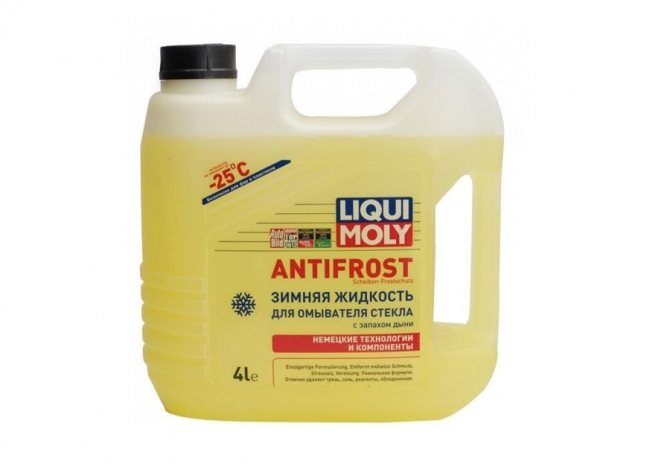

Russian Anti-freeze Effect Plus
Inexpensive domestic product based on isopropyl for washing car windows in frosts down to -30C. The advantages include the absence of:
- unpleasant pungent odors;
- harmful effects on human well-being;
- decomposing effect on the rubber elements of the glass and paintwork system.
To the disadvantages of this anti-freeze, experts attribute the inability to remove dirt and oil stains from cold glass (it is imperative to warm it up).
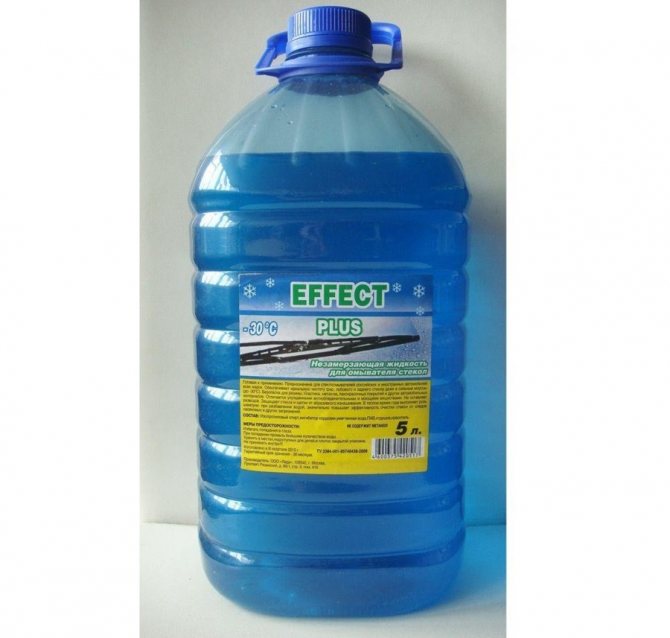

Windshield washer "Chistaya Milya" (RF)
This anti-freeze is produced in Russia, is in great demand among the domestic motorist and differs in:
- an exclusive and proven chemical formula based on isopropyl alcohol;
- the efficiency of removing dirt and oil at -35C;
- guaranteed safety for humans (does not contain methanol);
- no impact on rubber, metal and paintwork;
- the absence of spots and glare on the glass after drying;
- cost-effectiveness.
Experts warn car owners: there are many fakes of this windshield washer on the market. You can choose an original product by the light smell of acetone (if there is no smell, it is counterfeit).


Budget anti-freeze E95
This certified anti-freeze has a very affordable price and quite effectively cleans car windows from dirt and difficult stains, is safe for humans and is active at temperatures down to -30C. However, this product has not actually been tested and tends to thicken slightly already at -15C.
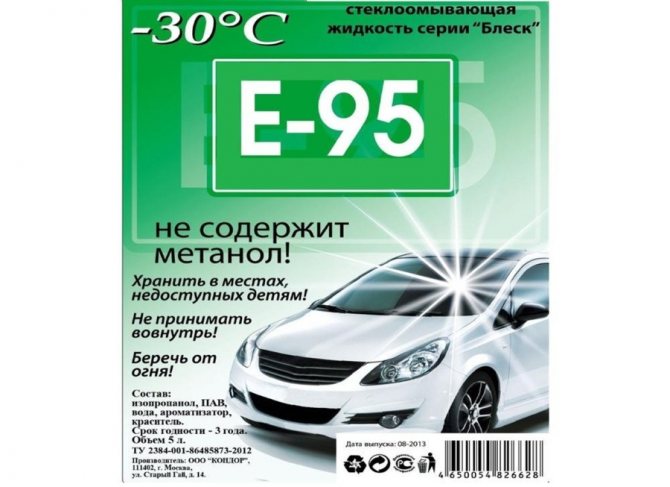

Can antifreeze be used
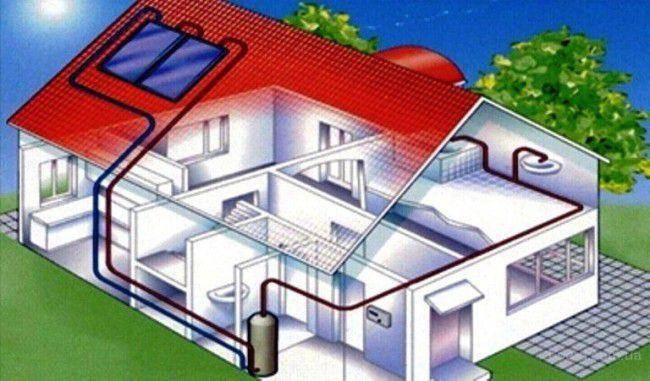

heat supply circuit with antifreeze instead of water
Antifreeze or antifreeze liquids are known to almost everyone. They are widely used in vehicle cooling systems in winter. In a car engine, antifreeze transfers excess heat from the engine, cooling it down. Moreover, even in the most severe frosts, it does not freeze. It is these properties - the ability to transfer heat even at the lowest temperatures and have led to the use of antifreeze for the construction of heating systems. It is especially important to use such a coolant in a system, part of the pipeline of which runs through an open area.
A good feature of “non-freezing” is that it provokes less corrosion on the inner surface of pipeline systems than ordinary water.Another undoubted advantage is the absence of suspended limestone solutions in antifreeze liquids - so you don't have to worry about possible scale formation.
There are several modifications of antifreeze fluids that can be used in heating systems. The choice of a specific type is made taking into account the climatic conditions and the configuration of the heating system of your home.
What is heating system flushing fluid and should it be flushed?
In addition to the heat carrier itself, when operating the heating system, you will also have to purchase a liquid intended for flushing with a pipeline and heating radiators.
Of course, as a last resort, you can rinse the inner surface of the pipes with ordinary tap water, but it is better to do this all the same with the help of special fluids, in which special chemical additives are introduced.
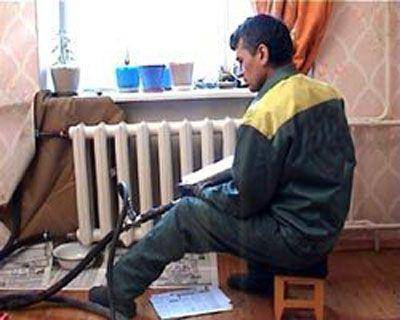

heating flushing
An alternative flushing option can be the use of water with a caustic soda solution added to it. Such a mixture is poured into the heating system and remains inside it for about an hour. The soda solution comes into contact with scale on the inner surface of the system and dissolves it. In addition, the baking soda solution will dissolve the corroded areas.
How to choose a liquid for a heating system?
First of all, it is necessary to determine the operating parameters of the system. Here, two extreme values will be important for you - the maximum temperature of the coolant when heated in the boiler and the minimum temperature of the ambient air. Next, you need to carefully study the technical characteristics of your heating system.
Actually, the main attention should be paid to the characteristics of the heat exchanger in the boiler. Some manufacturers may not allow the use of anti-freeze fluids. And, finally, after determining the permissibility of using an anti-freezing liquid and its possible temperature parameters, proceed directly to the choice of the brand of liquid, focusing on its lowest toxicity
All the same, the heating system will be located in a residential area, and possible fluid leaks should not lead to poisoning.
Using alcohol as a heat carrier
No matter how blasphemous it may sound for a man's ear, it is allowed to use alcohol as a heat carrier. The alcohol does not freeze and can be used over a wide temperature range. Naturally, industrial alcohol is used in this capacity, which is a deadly poison for humans. However, many manufacturers of boilers and heat exchangers are critical of the use of fluids such as bischofite or ethylene glycol as a heat carrier.
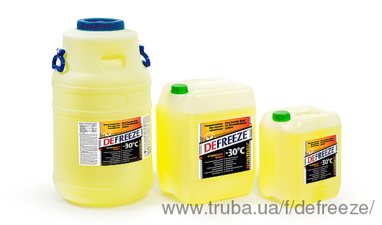

bischofite
The disadvantage of using pure alcohol as a heat carrier is its high volatility - about five liters per year will evaporate through microscopic pores in the system.
Composition of fluids for cars
There are three types of ready-made glass washers in winter:
... These are semi-legal liquids that are generally prohibited for use in Russia. But they can be bought cheap and they do well in mud, icing.
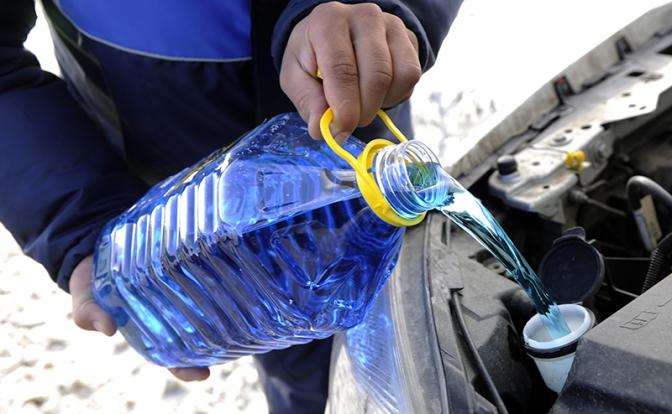
Methyl alcohol based- You just need to take into account that methanol is harmful to health, even if the motorist is not going to drink such an anti-freeze. It is undesirable to inhale vapors of the substance, this can lead to nausea and dizziness.
- Ethyl alcohol based... These are high quality but very expensive windscreen washer fluids. Ethanol is not harmful to health, being used for its intended purpose, it removes dirt well, protects the surface from the formation of an ice layer. But it is not always possible to buy such an anti-freeze, since due to the high cost of funds, the funds are not very common.
- Isopropyl alcohol based... These are the most commonly used glass fluids.They are inexpensive and do their job well. But they also have disadvantages: isopropyl smells strongly and increases the viscosity of the product in severe frost. The latter makes it unusable. In order for isopropyl-based anti-freeze to work at low temperatures, it must have a high concentration of the substance. This means that the smell will become even sharper.
The higher the temperature the product is designed for, the less it smells. Therefore, those who do not live in the far north should take a liquid that retains its properties at minus 20-25 degrees.
How to make an anti-freeze with your own hands
There are no standards for a fluid intended for pouring into a washer. Therefore, do-it-yourself non-freezing for a car is quite accessible to everyone, especially since the ingredients can be bought.
More on InDrive.Net:
ERA-GLONASS system in a car: features of operation and control
Composition and proportions of components
There are several recipes for making a windshield washer:
- Based on liquid for cleaning windows. But not every commercially available one will work, you need to choose a product containing alcohol. The composition of the anti-freeze for cars and the proportions of the components are as follows: 33% of liquid for cleaning windows, the rest is distilled water.
- Based on medical alcohol. A substance with a strength of 95 or 70 degrees is suitable. But proportions depend on this indicator. If the alcohol is 95 degrees, 650 g is needed, 750 g of a 70-degree antiseptic are taken. Water is measured in each case 3 liters. After mixing it with alcohol, add another 1 tbsp. washing powder and shake everything up.
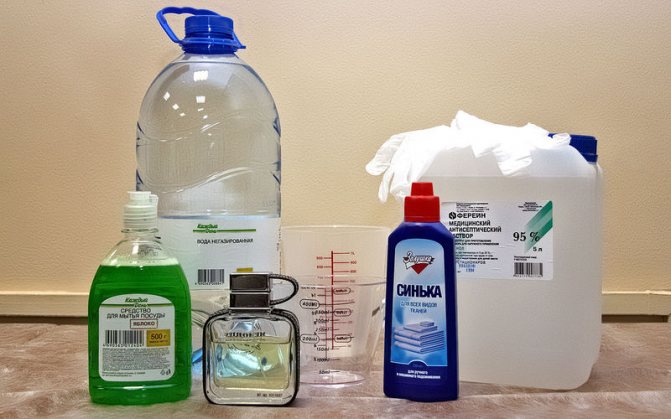

- Based on vinegar. In order not to look for a long time, from what they make an anti-freeze for a car, they take this available product and mix it with water in a 1: 1 ratio. The recipe is best used at a temperature outside the window of at least minus 10 degrees. Only in this case will the smell become weaker.
- Ammonia based. For 2 liters of water, take 1 liter of the substance. They are mixed using a spoon or twig to prevent foam from forming. Do not shake the container. To make the tool work in severe frost, add 100-150 g of vinegar to it. This liquid is very effective, but it has a pungent smell, so not every motorist can use the recipe.
The proposed methods for preparing non-freezing have been tested more than once. Still, you shouldn't cook large quantities right away. It is better to do a little to check if there will be any stains on the glass after using, whether the driver can tolerate the smell of the product. In all cases, it is worth taking bottled water, and not from the tap, unless distilled water is required according to the recipe.
How to make odorless liquid
Sensitive people should not use a strong-smelling product to clean the glass. Otherwise, discomfort and headache are provided for them, and driving it is dangerous. Need an anti-freeze for an odorless car, this can also be prepared at home.
More on InDrive.Net:
When, how and which child seat belt to use
Dishwashing liquid is taken as a basis. High-quality products contain a minimum of fragrances, they do not contain substances that negatively affect health. An important quality of the base is its immunity to low temperatures, which can be easily checked.
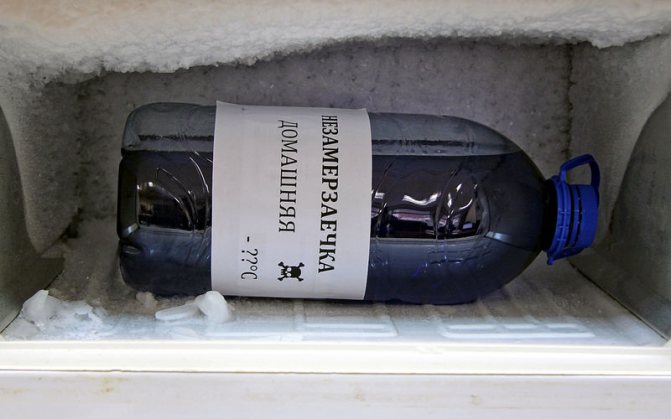

Concentrated liquid "Fairy" is suitable for preparation of anti-freeze. You need to measure out 1.5 tbsp. and stir in 5 liters of water. If you intend to use a different dishwashing detergent, the proportions must be determined experimentally.
Antifreeze based on ethanol and window cleaning fluid also have a fairly neutral odor. And if the product is needed for a short time, and there is no way to mess around with preparation for a long time, you can mix vodka with water. The smell from it quickly disappears, and in a mild cold, the product works well.
Shelf life
Many people buy a washer for future use. But the shelf life of anti-freeze for a car is limited.It depends on the composition and storage conditions. On average, this is 2-3 years from the date of manufacture. But it must be borne in mind that in warmth, alcohol, for example, can evaporate, and the effectiveness of the liquid will decrease. This is more likely if the container is open and the lid is loose.
Before the new season of using the anti-freeze left over from last year, it is better to test it. Only then should the washer container be filled. A deteriorated product may be indicated by a change in consistency, color or odor.
For information on how to cook an anti-freeze on your own, see this video:
Types of low-freezing liquids
Non-freezing liquid for heating a house is the same antifreeze or antifreeze. no difference. More precisely, there is a difference, but it is more about the composition of the anti-freeze, than the main properties. And their main property is not to turn into ice when the temperature drops, down to -60 degrees. In this case, the cooled composition thickens.
Propylene glycol is part of the eco-friendly anti-freeze
Any non-freezing liquid for heating, a warm house in particular, is made according to the same principle. Their composition:
- glycolic (alcohol) base;
- the main active ingredient;
- substances that prevent corrosion (inhibitors);
- substances responsible for the characteristics of the composition (additives).
So, it is already clear that non-freezing liquid for water heating is an alcoholic substance. Glycol by itself is not dangerous, but some additives can be very harmful to health. The following can act as an active component in anti-freeze:
Ethylene glycol liquid, in which ethylene glycol acts as an active substance, is strongly discouraged from using in homes of permanent residence. It is very toxic and causes burns when it gets on the skin. The ingestion of the composition into a person in the form of a liquid or gas leads to serious consequences, up to and including death.
Low-quality antifreeze and the well-known machine antifreeze, which is also sometimes poured into heating, are made on an ethylene basis. If there is even the slightest possibility of human contact with ethylene glycol, then it is better to refuse its use:
- Evaporation from an open-type expansion tank;
- a leak;
- mixing into the DHW circuit in double-circuit boilers.
Do not use ethylene glycol antifreeze liquids for heating, where a double-circuit boiler acts as a heater.
Propylene glycol liquid for heating boilers, non-freezing, is completely non-toxic. This does not mean that you can drink it, but accidental contact with minimal doses on the skin or even inside will not lead to health complications. This anti-freeze can be used safely.
Glycerin antifreeze liquid has been poured into the heating system since the middle of the twentieth century and is still successfully used. Glycerin is, in general, a universal remedy. What is characteristic, unlike the above two types of non-freezing, glycerin does not dry the rubber, but, on the contrary, restores it, gives a second life. That is, it acts on it like a silicone lubricant, so there is no need to worry about the condition of the sealing gum.
The problem of heating the winter greenhouse has been solved, everything is quite simple.
Varieties


Regardless of the type of antifreeze liquid, it will always contain the same compounds:
- The foundationmade from alcohol or ethylene glycol.
- Key active ingredient.
- Connectionsthat do not allow the occurrence of corrosion processes (inhibitors).
- Additiveswhich are responsible for the key properties of the fluid.
By itself, the alcohol base is not harmful to human health, and various compounds that make up the non-freezing liquid can do harm. The composition of antifreeze directly depends on where it will be used.Many who use such means for heating systems agree that it is better not to purchase formulations where ethylene acts as an active compound.
It is highly toxic and can even cause burns. If it gets inside a person, it can lead to death in especially severe cases.
It is strictly forbidden to use ethylene glycol fluids of antifreeze type if a double-circuit boiler acts as a heat source. Propylene glycol liquid is absolutely harmless.
How to choose the right liquid for heating
It is difficult to imagine comfortable living in an apartment or a private house without high-quality heating. Residents of urban high-rise buildings with centralized heating are lucky. After all, you don't have to think and worry about the safety of pipes during the cold period. Maintenance falls on the shoulders of housing maintenance offices. But the proper operation of the autonomous heating system in the private sector has to be monitored independently.
A heat carrier is used as a heating element in the heating network. It is a heating fluid that circulates around the circuit. It can be of different types. It is on what fluid is used that the operation and maintenance of the system depends. Therefore, this article will be devoted to the coolant, its types and application rules.
Characteristics of antifreeze heating fluids
The way a low-freezing liquid for heating systems behaves in the circuit is primarily influenced by the quality of the additive package and, of course, the operating conditions. Regardless of which main active element is added to the glycol base, all formulations have anti-corrosion and anti-foaming properties.
Without these additives, the heating fluid is very corrosive. All non-freezing liquids foam, but especially glycerin anti-freezing liquids for heating systems of houses. Foam is an air-containing substance, and air leads to impaired circulation, the formation of air pockets, as well as water hammer in the heating system.
The additive package has its own time resource. After a certain time, the additives disintegrate at the molecular level.
This will form a precipitate and release acid. It turns out that nothing already smoothes the aggressiveness of the coolant for heating the house, moreover, everything is aggravated by the release of acid. Service life of antifreeze liquid:
- based on ethylene glycol - five years;
- based on propylene glycol - five years;
- glycerin-based - up to ten years.
This is the service life of the compound under favorable operating conditions. The main requirement is, of course, temperature. When the temperature of the coolant rises to 90 degrees, the non-freezing liquid begins to disintegrate and loses its properties. This only happens if the boiler starts up incorrectly after a long period of inactivity, or if there are errors during installation.
Direct contact of the heat exchanger with the flame is undesirable if antifreeze is poured into the circuit
For example, when a heat exchanger is built into a conventional oven. Some people install it so that it is in contact with an open flame. If you plan to use antifreeze for stove heating, then this should not be done. It is necessary that there is a layer of brick between the heat exchanger and the flame. He and the coolant will protect from too hot tongues of flame, and distribute the heat evenly. In this case, the non-freezing liquid for stove heating will not overheat.
Characteristics influenced by the quality of the additive package:
- thermal conductivity;
- density;
- viscosity;
- fluidity;
- thermal expansion.
The higher the quality of the additives, the higher the characteristics will be. That is, as close as possible to the characteristics of water. In the case of the coefficient of thermal expansion, then it should be as small as possible.
Considering the fact that the volumetric expansion of the anti-freeze is greater than that of water, it is necessary to provide for an expansomat of 40% more volume.
The thermal conductivity of antifreeze is lower than that of water. The lowest thermal conductivity of glycerin antifreeze liquids. In relation to water, it is only 85%; in other non-freezing systems, the indicator can reach 90%. As you can see, the difference is not that great.
Non-freezing liquids are half as dense and viscous as water. These qualities impede circulation. In order to pump the coolant along the circuit, a pump of greater power will be required; it would also be nice to assemble a heating circuit from pipes with a cross section larger by one step. For example, when it comes to polypropylene pipes. then instead of 25 in diameter, it is better to take 32.
Despite the fact that an anti-freeze liquid is denser and more viscous, it has a lower surface tension coefficient, that is, it is more fluid. Do you know that you can draw water into a glass "with a slide"? The slide, of course, will be small, but even visually it is visible that the liquid rises above the edge of the vessel. With anti-freeze, this will not work. Due to this high fluidity, it flows out where water does not penetrate due to surface tension. In other words, if there are microcracks and even very small holes, then the non-freezing liquid will find a way out there.
Therefore, often, after there was water in the circuit and it was decided to pour an anti-freeze into it, leaks appear. Major leak points:
- pipe joints;
- connections between radiator sections;
- places for connecting additional elements;
- in the boiler itself.
Water has another useful property, thanks to which a minor leak can disappear by itself. Metal particles settle at the edges of the cracks and seal them. Of course, this is just scale, which, in the case of flushing and further pressure testing of the system, will be removed and the flow will resume.
How to make an antifreeze liquid
Knowing the recipe, making a similar product yourself is quite simple. It is necessary to mix the necessary components in the right proportion, after which the liquid can be used for its intended purpose. From what substances are used, the properties of a homemade anti-freeze may differ from the standard one.
Related article: Review of Quiet Summer Car Tires
It should be borne in mind that in some cases, knowing how to make a frost-resistant liquid yourself may be necessary.
How to choose the right fluid
Today, there are hundreds of product options on the market for heating devices and consumables.
It is quite difficult to choose high-quality and safe antifreeze among them, because each brand uses all kinds of marketing tricks to attract the attention of the buyer to their product. In order not to fall for the fishing rods placed by advertisers, the homeowner needs to understand what requirements the liquid for heating boilers, poured into the circuit, must meet.
Before you buy heating fluid. the owner needs to find out some of the technical characteristics of the boilers, as well as familiarize himself with the list of antifreezes that are compatible with radiators and pipelines connected to the circuit. In addition, it is necessary to clarify the operating parameters of the heating system and the features of operation. Next, you should study the specific requirements of specialists for antifreeze that can make the heating system productive, stable and safe.
Pay attention to the following parameters:
- Operating temperature range;
- heat capacity;
- inertness of the chemical composition;
- the presence of anti-corrosion properties;
- no sediment in the liquid when heated;
- stability of chemical properties - density, viscosity, heat capacity;
- no toxic emissions during use.
Functional heating boilers liquid fuel, gas and solid fuel will last much longer if they are filled with antifreeze with a maximum operating temperature range, stable chemical composition and acceptable performance, guaranteeing the protection of heating devices from corrosion, scale and solid sediment. You can buy such a liquid only from a trusted manufacturer. But the use of the wrong antifreeze can lead to a number of undesirable effects.
Negative effects that may appear:
- the formation of foam inside the circuit when the coolant is heated;
- precipitation, which provokes overgrowing of pipes and clogging of the boiler heat exchanger;
- corrosion formation;
- the appearance of leaks;
- violation of the boiler tightness;
- the release of toxic substances.
Popular brands of anti-freeze
Many companies produce anti-freeze fluids for windshield washers. At the same time, there are a lot of counterfeit products on the market, and it is better to refrain from using them in order to avoid health problems. Anti-freeze products differ in price, temperature range, chemical composition and other parameters. Among the most popular brands under which anti-freezing fluids for cars are produced, one can single out:
- LIQUI MOLY;
- Hi-Gear;
- AGA;
- Spectrol;
- Pingo.
We strongly advise against buying an anti-freeze of unknown production on the highway or in an unknown auto shop in order to avoid problems with the paintwork and the health of people who drive in the car. The main danger is emitted vapors, which are sucked into the interior of the car and inhaled by people.





